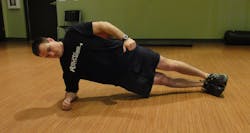FHExpo16: 10 Best Firefighter Exercises to Improve Fitness
The importance of staying fit for duty is obvious. Your life and the lives of your crewmembers and community members depends on you being healthy enough to climb a ladder, stretch a hose, breach a window, the list goes on. But how do you ensure that you’re training the right muscles in the right way to maximize your time and effort?
In his Friday morning session “10 Best Exercises for Firefighters” at Firehouse Expo, Aaron Zamzow offered a list of 10 exercises that firefighters should focus on to ensure they are ready for the tasks at hand. Before the show, I had the opportunity to talk to Zamzow, who is a firefighter/training officer with the Madison, WI, Fire Department, as well as a certified personal trainer and owner of Fire Rescue Fitness.
Zamzow explains that these particular exercises are useful for firefighters because they address the “on-the-field” requirements of the job, particularly functional core strength, power and endurance. He says that most of the traditional weight-lifting machines seen in most firehouses don’t “functionally” address the physical challenges that firefighters need, nor do the bodybuilding, P90X and “Insanity” training programs. “Fire rescue athletes must use their entire body at any given moment during their job performance,” he says. “Multi-joint, whole-body exercises utilizing varying loads, muscular contraction speed and duration will benefit the fire rescue athlete far more than bodybuilding-style training, or traditional weight-lifting machines.”
With this in mind, Zamzow compiled a list of exercises (or fitness categories) that have specific applications to the movements on the fireground.
1. Planks: Zamzow reminds that back injuries are the number one reason firefighters and medics go on early disability, so it should be no surprise that the first exercise on the list is a core exercise. “The plank requires no equipment and will increase core efficiency, allowing the body to have greater control and stability,” he says. You can also try multiple positions: plank, side plank and bridge.
2. Intervals: Interval training is training in which the intensity is intermittently raised for hard work and then lowered for recovery. This mimics the metabolic demands of most firefighting duties. Zamzow explains that because heart rates can rise dramatically with mental stress and physical work, firefighters must prepare their body for this kind of physiological load by using a well-designed cardiovascular program. “Intervals help firefighters build a cardiovascular training program that enables us to work longer and harder with less physical pain when it really counts,” he says. “They also help the body to more efficiently flush muscles of lactic acid and more efficiently burn fat.”
3. Active Warm-ups: These are slow, controlled, easy movements that increase blood flow and flexibility of muscles. Zamzow says each one of your workouts should start with a short cardiovascular exercise followed by specific active stretching movements. “The warm-ups prepare the body for movement; boost heart rate, blood flow to the muscles and core temperature; and improve the function of your nervous system,” he says. “Active warm-ups not only increase flexibility of your muscles before the workout, they also help them remain flexible for the rest of the day.
4. Single-leg touchdowns: For a single-leg touchdown, balance on your right leg with your knees slightly bent, slowly bend your knee to lower your body toward the floor while reaching toward the outside of your right foot with your left hand. Push through your heel and squeeze your glutes to return to the starting position. Then do the same on the other foot. Zamzow says this is a great exercise because it helps strengthen key muscles (including the hamstrings, glutes and the muscles just above the knee cap on the inside of the leg) to manage and prevent chronic knee and back pain.
5. Farmers Carry: To do the Farmers Carry, grab some fairly heavy objects, engage the core by bracing your abs and slowly walk (chest up, good posture). The longer you walk and the heavier the item, the more you challenge the core and your grip. Zamzow explains that this exercise is particularly useful because firefighters are often moving in unbalanced positions and often have to carry heavy loads and equipment. “The Farmers Carry addresses both of these issues because it engages the core and at the same time improves grip strength,” he says.
6. Prisoner Squats: Also known as the Bodyweight Squat, the Prisoner Squat targets your quadriceps and activates your core and every other muscle in your lower body, including your glutes, hamstrings and calves. To do them, stand as tall as you can with your feet shoulder-width apart. Place your fingers on the back of your head (as if you had just been arrested, hence the name prisoner squats). Pull your elbows and shoulders back. Brace your core and hold it that way. Lower your body as far as you can by pushing your hips back and bending your knees. You should try to get the tops of your thighs parallel to the floor. Pause, then slowly push yourself back to the starting position. Zamzow says this exercise is great because you don’t need any equipment and yet still work important muscles. “In addition to their strength-building benefits, squats also teach you core stabilization, which is important for almost any movement on the fireground.”
7. Bent-Over Ts and Ys: Stand with feet hip-width apart and bend forward at the waist, keeping a straight back (not rounded). Draw your navel toward your spine and squeeze your glutes for spinal stabilization. Raise your arms in a “Y” formation, keeping thumbs pointed up at the ceiling. Lower your arms back to the starting position, then raise your arms in a “T” formation with your thumbs pointed down toward the floor. Alternate between the “Y” and “T” formations until reps are completed. Zamzow suggest performing 10 to 15 reps of this exercise every day. “This is a great exercise to warm up and strengthen the deep muscles of the shoulders and upper back,” he says. “They improve your posture and reduce your risk of shoulder injury. It only takes two minutes and could save your career.”
8: Body Rows: Zamzow says these exercises improve pulling strength of the upper-back, shoulders and arm muscles, as well as the stabilizing strength in the low back, glutes and hamstrings. For this exercise, you’ll need a horizontal bar or a TRX suspension system that can support your body weight. With your feet acting as a fulcrum, pull your chest up to the bar by bending your elbows and pulling them backward. Return to the starting position by straightening your arms in a controlled manner, and repeat. If this version of the body row is too difficult, you can bend your knees and use your legs for assistance. “The body row does for the back side of the body what the push-up does for the front side,” Zamzow adds.
9: Crawling: It might sound odd, but Zamzow says crawling is a great exercise to work core stability, strengthen the shoulder girdle and improve coordination. He recommends using a variety of directions and positions (forward, lateral, pulling objects). “Focus on keeping your hands under your shoulders to avoid shoulder impingement and tighten core muscles during the exercise,” he says. Zamzow describes one of the most basic crawls, the bear crawl, which involves keeping your hips high in the air with your arms and legs straight. In the spider-crawl, instead of keeping your hips up, bend your arms and legs while keeping your hips down.
10: Foam-rolling: A foam roller is a piece of compressed foam. The idea here is that you roll your body weight along the foam roller, massaging through restrictions (adhesions) that may occur in your muscles (especially those of the back and legs) and thus causing the nerves to relax and loosen. “This allows blood to flow more freely through the muscles and allow muscles to heal and repair more efficiently,” Zamzow says. To do it, place a sore/tender muscle group (quads, hamstrings, calves, IT band, chest, back) on the roller and roll over the sore area slowly, holding for a couple seconds over each trouble area. Hold your position on the sore spots for a couple of seconds. Re-position your body to hit the sore spot from different angles.
In sum
Zamzow underscores that it’s important to focus exercises on those that will improve your performance on the fireground—and that starts with having a plan. But he cautions, “Form is more important than weight, especially when dealing with core and balance exercises,” he says. “Stay fit, stay balanced and stay ready for duty.”
About the Author

Janelle Foskett
Janelle Foskett served as editorial director of Firehouse Magazine and Firehouse.com, overseeing the editorial operations for the print edition along with working closely with the Web team.
